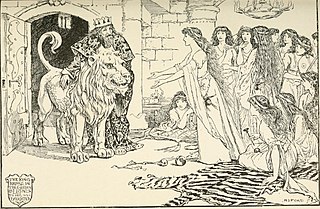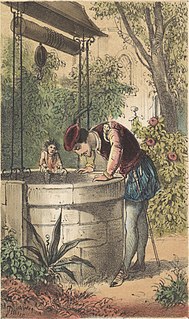
"The Twelve Dancing Princesses" is a German fairy tale collected by the Brothers Grimm and published in Grimm's Fairy Tales in 1812. It is of Aarne-Thompson type 306.

The Black Bull of Norroway is a fairy tale from Scotland. A similar story titled The Red Bull of Norroway first appeared in print in Popular Rhymes of Scotland by Robert Chambers in 1842. A version titled The Black Bull of Norroway in the 1870 edition of Popular Rhymes of Scotland was reprinted in an Anglicised version by Joseph Jacobs in his 1894 book More English Fairy Tales.

The Langs' Fairy Books are a series of 25 collections of true and fictional stories for children published between 1889 and 1913 by Andrew Lang and his wife, Leonora Blanche Alleyne. The best known books of the series are the 12 collections of fairy tales also known as Andrew Lang's "Coloured" Fairy Books or Andrew Lang's Fairy Books of Many Colors. In all, the volumes feature 798 stories, besides the 153 poems in The Blue Poetry Book.
The Red Ettin or The Red Etin is a fairy tale collected by Joseph Jacobs. It was included by Andrew Lang in The Blue Fairy Book.
The Brown Bear of Norway is an Irish fairy tale collected by Patrick Kennedy which appeared in his Legendary Fictions of the Irish Celts (1866). It was later included by Andrew Lang in his anthology The Lilac Fairy Book (1910), though Lang misattributed his source as West Highland Tales.
The Fair Fiorita is an Italian fairy tale collected by Thomas Frederick Crane in Italian Popular Tales. Italo Calvino included a variant of it, The Princesses Wed to the First Passer-By, in his Italian Folktales.

"The Queen Bee" is a German fairy tale collected by the Brothers Grimm in Grimm's Fairy Tales. It is of Aarne-Thompson type 554.
The Hairy Man is a Russian fairy tale. Andrew Lang included it in The Crimson Fairy Book.
The Dragon and the Prince or The Prince and the Dragon is a Serbian fairy tale collected by A. H. Wratislaw in his Sixty Folk-Tales from Exclusively Slavonic Sources, tale number 43. Andrew Lang included it in The Crimson Fairy Book.
How the Hermit Helped to Win the King's Daughter is an Italian fairy tale, collected by Laura Gonzenbach in Sicilianische Märchen. Andrew Lang included it in The Pink Fairy Book.

The Golden Lion is an Italian fairy tale collected by Laura Gonzenbach in Sicilianische Märchen. Andrew Lang included it in The Pink Fairy Book.
The Mermaid and the Boy is a Sámi fairy tale collected by Josef Calasanz Poestion in Lapplandische Märchen. Andrew Lang included an English-language version in The Brown Fairy Book (1904).
The Ram is a French literary fairy tale by Madame d'Aulnoy.
The Grateful Prince is an Estonian fairy tale.
King Kojata or The Unlooked for Prince or Prince Unexpected is a Slavonic fairy tale, of Polish origin. Louis Léger remarked that its source was "one of the most important collections of Polish literature".

What came of picking Flowers is a Portuguese fairy tale first collected by Teophilo Braga with the name Cravo, Rosa e Jasmin. Andrew Lang included it in The Grey Fairy Book.
"The Rider Of Grianaig, And Iain The Soldier's Son" is a Scottish fairy tale collected by John Francis Campbell in Popular Tales of the West Highlands (1860–62), listing his informant as Donald MacNiven, a lame carrier, in Bowmore, Islay; the story was written down by Hector MacLean on 5 July 1859. Andrew Lang included it in The Orange Fairy Book (1906) as "Ian, the Soldier's Son".
"The Griffin" is a German fairy tale collected by the Brothers Grimm in Grimm's Fairy Tales.
Făt-Frumos with the Golden Hair or The Foundling Prince is a Romanian fairy tale collected by Petre Ispirescu in Legende sau basmele românilor.

"The Gnome" is a German fairy tale collected by the Brothers Grimm in Grimm's Fairy Tales, tale number 91.






